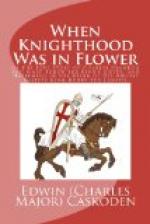At Cincinnati, the following week, the contract was signed and the search for the dramatist was begun. That the story would lend itself happily to stage production must have occurred even to the thoughtless reader. But it is one thing to see the scenes of a play fairly sticking out, as the saying is, from the pages of a book, and quite another to gather together and make of them a dramatic entity. Miss Marlowe was determined that the book should be given to a playwright whose dramatic experience and artistic sense could be relied on to lead him out of the rough places, up to the high plane of convincing and finished workmanship. Mr. Paul Kester, after some persuasion, undertook the work. The result is wholly satisfactory to author, actress and manager—a remarkable achievement indeed!
Mr. Major’s biography shows a fine, strong American life. He was born in Indianapolis, July 25, 1856. Thirteen years later he went with his father’s family to Shelbyville, where he was graduated from the public school in 1872, and in 1875 he concluded his course in the University of Michigan. Later he read law with his father, and in 1877 was admitted to the bar. Eight years later he stood for the Legislature and was elected on the democratic ticket. He served with credit one term, and has since declined all political honors.
The title, When Knighthood was in Flower, was not chosen by Mr. Major, whose historical taste was satisfied with Charles Brandon, Duke of Suffolk. And who knows but that the author’s title would have proved just the weight to sink a fine book into obscurity? Mr. John J. Curtis, of the Bowen-Merrill Company, suggested When Knighthood was in Flower, a phrase taken from Leigh Hunt’s poem, the Gentle Armour:
“There lived a knight,
when knighthood was in flower,
Who charmed alike the tilt-yard
and the bower.”
* * * * *
Transcriber’s note—typographical errors corrected in text:
Page 15: Gentlema replaced with Gentleman
Page 102: way replaced with was
Page 154: extra ‘the’ removed
Page 306: Garcon replaced with Garcon



